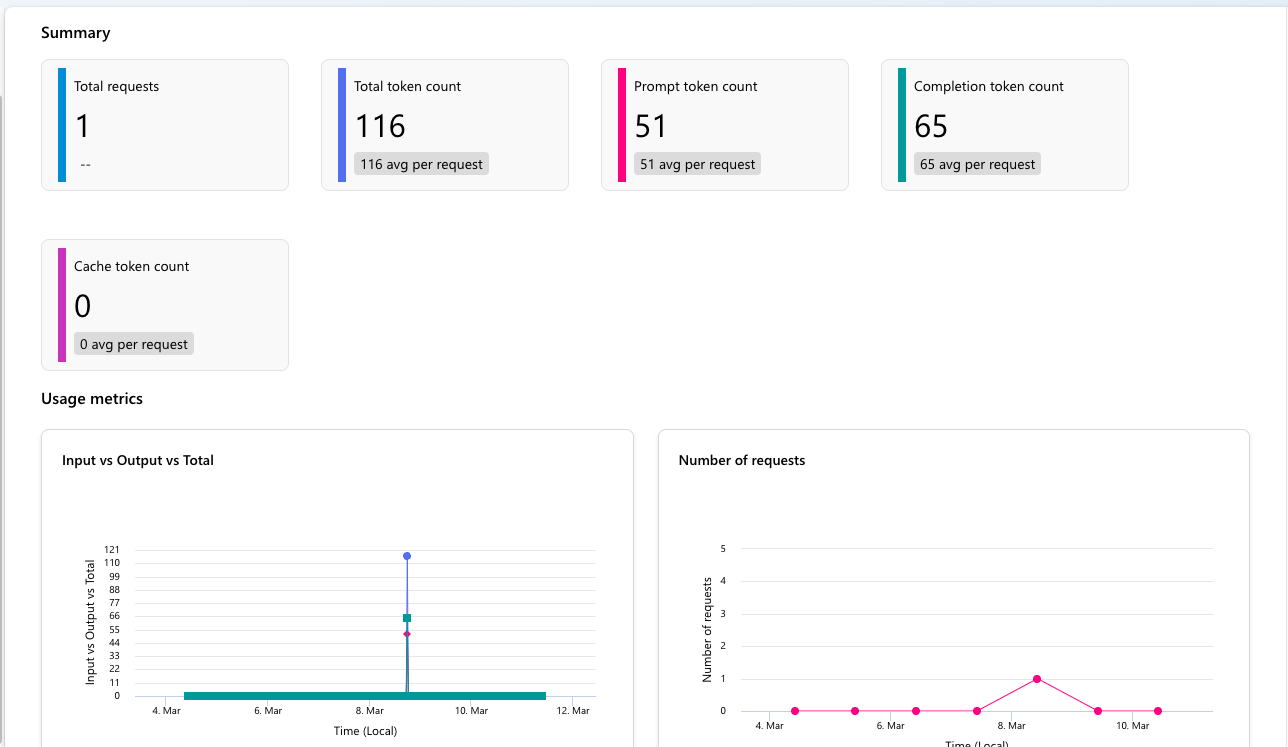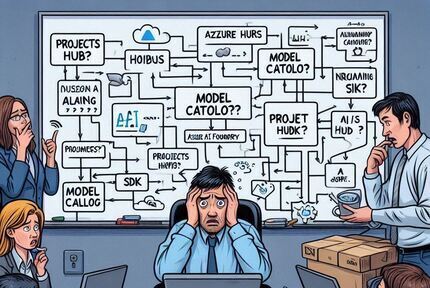Decoding Azure AI Foundry: A Guide to Naming & Structure
Confusion to clarity
Introduction
As artificial intelligence (AI) becomes a core part of modern businesses, Azure AI Foundry emerges as a powerful platform to simplify AI model development, deployment, and management. However,with the transiiton of Azure OpenAI services to foundry the nomenclature was bit overwhelming for me. This blog is basically for anyone who are in my zone and this single blog may not cover all and as and when I start exploring new concepts I will ensure the blog is updated.
Comprehensive Nomenclature for Azure AI Foundry
Azure AI Foundry is a powerful platform designed to streamline the development, deployment, and management of AI applications. Here are some key components to understand
1. Projects
Containers for organizing and managing AI development work.
- Collaboration: Facilitate teamwork with shared resources and version control
- Data Management: Securely store and manage datasets
- Model Deployment: Seamlessly deploy models to production environments
- Testing: Tools for evaluating model performance and accuracy
2. Hubs
Top-level resources that manage multiple projects.
- Security Configurations: Managed networks and access controls
- Compute Resources: Provisioning for development, fine-tuning, and deployment
- Service Connections: Integrations with other Azure services like Azure OpenAI and Azure AI Services
3. Management Center
Streamlines governance and management of resources.
- Resource Management: Oversee hubs, projects, and connected resources
- Deployment Management: Monitor and manage model deployments
4. SDK (Software Development Kit)
A set of tools and libraries for developing AI applications.
- Model Access: Utilize pre-built and custom models
- Data Integration: Connect to various data sources
- Service Management: Manage AI services programmatically
5. Model Catalog
A repository of pre-built and customizable AI models.
6. Model Training
The process of developing an AI model using data and machine learning techniques. Am not sure if its applicable in this scenario.
7.Model Deployment
The process of making the trained model available for real-world use.
- Foundation Models: General-purpose models for various tasks
- Task-Specific Models: Models tailored for specific applications
- Industry Models: Specialized models for different industries
8. Agents
In Azure AI Foundry, agents act like intelligent assistants, each with a specific job to keep AI-powered operations running smoothly. They help automate tasks, manage AI models, and ensure everything works efficiently—almost like a well-organized team where each member plays a crucial role.
What Do Agents Do?
- Automate Repetitive Work – Agents handle routine AI tasks like cleaning data, running models, and generating reports so teams can focus on more strategic work. Keep AI Models Running – They make sure AI models are trained, deployed, and monitored, so businesses can rely on accurate and timely insights.
- Make Smart Decisions – Some agents analyze data in real time and make AI-driven recommendations, improving efficiency and decision-making.
- Ensure Smooth Operations – By managing workflows and scaling AI processes, agents help businesses get the most out of their AI investments.
9. Assistant
In Azure AI Foundry, an Assistant is an advanced AI-powered entity designed to interact, assist, and automate tasks for users within the Foundry environment. It acts as an intelligent guide that helps users navigate AI workflows, manage resources, and streamline operations by providing insights, recommendations, and automation capabilities.
10. Memory
Storing and retrieving information from past interactions.This plays vital role while dealing with interactions and costs , so this acts as a key element in planning.
- Contextual Understanding: Enhance the contextual awareness of AI agents
11. Responsible AI
Ensuring AI is developed and used ethically. I have many sessions explaining this, links below
- Bias Detection: Identify and mitigate biases in AI models
- Fairness: Ensure equitable outcomes
- Transparency: Provide clear explanations of AI decisions
- Accountability: Maintain accountability for AI actions
12. Metrics
The dashboard that contains the details of models and its beautiful and very handy in comparison

13. Security and Compliance
Ensuring data privacy and regulatory compliance.
- Data Encryption: Protect data at rest and in transit
- Access Controls: Manage user permissions and access
- Compliance Certifications: Adhere to industry standards and regulations
14. Fine Tuning
Fine-tuning in Azure AI Foundry is like customizing a pre-trained AI model to fit your specific needs. Instead of building an AI from scratch, you take an existing model and teach it with your own data, making it more relevant and accurate for your use case.
15. Stored Completions
Stored completions in Azure AI Foundry are saved AI-generated responses that can be reused instead of recalculating the same output. This helps speed up responses, reduce processing time, and keep answers consistent. Imagine asking an AI to summarize clinical trials—if someone else asks later, the AI simply retrieves the stored summary instead of reanalyzing everything.
Real-World Scenario: Why PharmaCo Uses Multiple Hubs and Projects
To ensure ease of understanding, let’s take the example of a global pharmaceutical giant, PharmaCo, which leverages AI for drug discovery, clinical trials, and patient care. With such a complex and high-stakes operation, organizing its Azure AI Foundry resources effectively isn’t just a best practice—it’s essential. To maintain efficiency, ensure compliance, and scale seamlessly, PharmaCo structures its AI environment into multiple hubs and projects, creating a well-orchestrated system that supports innovation while keeping everything in check.
📌 PharmaCo’s Azure AI Foundry Structure
PharmaCo’s Azure AI Foundry environment is divided into three major hubs, each catering to a specific function:
🔹 Hub 1: Drug Discovery
📌 Objective: Use AI to accelerate the identification of new drug candidates.
📌 Region: Located in the US to comply with local pharmaceutical regulations.
📌 Security: Strict access controls to protect proprietary research data.
📌 Resources: High-performance computing clusters for AI simulations.
📍 Projects within Drug Discovery Hub:
- ✅ Project A – Compound Screening: AI models analyze chemical compounds to identify potential drug candidates.
- ✅ Project B – Protein Folding: AI predicts protein structures and their interactions for drug targeting.
- ✅ Project C – Toxicity Prediction: AI estimates potential toxicity of new drug compounds based on historical data.
Why Multiple Projects?
- 🔹 Specialization – Each project focuses on a distinct stage of drug discovery.
- 🔹 Efficiency – AI teams can work on different drug categories in parallel.
- 🔹 Resource Allocation – AI compute power is distributed based on project complexity.
🔹 Hub 2: Clinical Trials
📌 Objective: Optimize clinical trial processes and patient recruitment.
📌 Region: Located in the EU to comply with GDPR and EMA (European Medicines Agency) regulations.
📌 Security: Strict patient data privacy policies to protect medical records.
📌 Resources: AI-driven hospital databases, electronic health records (EHR), and trial monitoring tools.
📍 Projects within Clinical Trials Hub:
- ✅ Project D – Patient Recruitment: AI identifies suitable patients for clinical trials based on genetic markers and medical history.
- ✅ Project E – Trial Monitoring: AI tracks real-time patient data, ensuring trials remain compliant and efficient.
- ✅ Project F – Outcome Prediction: AI predicts clinical trial results based on real-world patient data and prior research.
🔹 Hub 3: Patient Care
📌 Objective: Develop AI-driven solutions for personalized patient care and treatment optimization.
📌 Region: Located in APAC to cater to regional healthcare providers and regulatory bodies.
📌 Security: Ensuring HIPAA and ISO 27001 compliance for patient data privacy.
📌 Resources: AI models integrated with wearable health devices, hospital systems, and telemedicine platforms.
📍 Projects within Patient Care Hub:
- ✅ Project G – Personalized Treatment Plans: AI tailors medication and therapy plans for patients based on their genetic profiles and lifestyle.
- ✅ Project H – Remote Monitoring: AI-enabled wearable devices track patient vitals and detect early warning signs of health issues.
- ✅ Project I – Predictive Analytics: AI anticipates potential health risks by analyzing patient history and real-time vitals.
📌 How Multiple Hubs and Projects helped in this usecase
1️⃣ Operational Efficiency – Hubs help PharmaCo group related projects, avoiding fragmentation.
2️⃣ Security & Compliance – Patient and research data is handled securely across different regions based on local laws.
3️⃣ Scalability – Different hubs allow teams to scale AI research and clinical applications independently.
4️⃣ Collaboration & Innovation – AI projects across different hubs share insights, enhancing drug discovery and patient care outcomes.
By structuring Azure AI Foundry with multiple hubs and specialized projects, PharmaCo ensures efficiency, compliance, and scalability, ultimately advancing AI-driven healthcare solutions globally.
I will cover more details taking this as primary example for all the other chapters 🚀
Liked this post ? You can buy me a coffee
